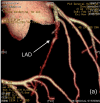Computed tomography angiography-guided percutaneous coronary intervention in chronic total occlusion
- PMID: 20669346
- PMCID: PMC2916089
- DOI: 10.1631/jzus.B1001013
Computed tomography angiography-guided percutaneous coronary intervention in chronic total occlusion
Abstract
Objective: The aim of this study is to investigate if dual-source computed tomography (DSCT) could guide the percutaneous coronary intervention (PCI) of chronic total occlusion (CTO).
Methods: We enrolled patients who were confirmed to have at least one native coronary artery CTO by DSCT before they underwent selective PCI in the period from December 2007 to October 2008. A CTO was defined as an obstruction of a native coronary artery with no luminal continuity. The CT-guided PCI procedure involved placing CT and fluoroscopic images side-by-side on the screen. DSCT images were analyzed for location, segment, plaque characteristics, calcification, and proximal lumen diameter of the CTO before PCI. The guidewire was advanced and manipulated under CT guidance. The PCI was carried out and the results were compared.
Results: Seventy-four CTOs were assessed. PCI was successful in 57 cases of CTOs (77.0%). According to the results, CTOs were divided into two groups: successful-PCI and failed-PCI. All coronary artery paths of CTOs were clearly recognized by DSCT. In the successful-PCI group, soft plaques were detected much more often than those in the failed-PCI group, but fibrous and calcified plaques were seen more often in the failed-PCI group. Calcification severity in CTO segments showed a significant difference between the groups (P=0.014). Calcified plaques were detected in 20 (35.1%) lesions in the successful-PCI group. More than 70% of the failures were calcified plaques, of which there were two arc-calcified and one circular-calcified lesions. Occlusions were longer in the failed-PCI group than those in the successful-PCI group [(38.8+/-25.0) vs. (18.0+/-15.3) mm, respectively, P<0.01]. Fewer guidewires were used in the successful-PCI group compared with the failed-PCI group (1.7+/-1.0 vs. 2.5+/-0.9, respectively, P<0.01). The logistic regression analysis indicated that predictors of recanalization of CTOs included occlusion length (P=0.0035, risk ratio (RR)=0.93) and calcification severity (P=0.05, RR=0.27). Multi-linear trends analysis showed that the factors affecting procedural time were CTO location (P=0.0141) and occlusion length (P=0.0035).
Conclusions: DSCT could delineate the path of CTOs and characterize plaques. The outcomes of PCI were related to thrombolysis in myocardial infarction (TIMI) flow grade, CTO characteristics, severity of calcified plaques, and the length of occlusive segments. Occlusion length and calcification severity were independent predictors of CTOs. Occlusion length and CTO segments could also help to estimate the duration of interventional procedures.
Figures




Similar articles
-
The predictors of successful percutaneous coronary intervention in ostial left anterior descending artery chronic total occlusion.Catheter Cardiovasc Interv. 2014 Oct 1;84(4):E30-7. doi: 10.1002/ccd.25514. Epub 2014 May 13. Catheter Cardiovasc Interv. 2014. PMID: 24740864
-
Impact of 16-slice computed tomography in percutaneous coronary intervention of chronic total occlusions.Catheter Cardiovasc Interv. 2006 Jul;68(1):1-7. doi: 10.1002/ccd.20734. Catheter Cardiovasc Interv. 2006. PMID: 16755596
-
Effect of Coronary CTA on Chronic Total Occlusion Percutaneous Coronary Intervention: A Randomized Trial.JACC Cardiovasc Imaging. 2021 Oct;14(10):1993-2004. doi: 10.1016/j.jcmg.2021.04.013. Epub 2021 Jun 16. JACC Cardiovasc Imaging. 2021. PMID: 34147439 Clinical Trial.
-
Computed tomography as a tool for percutaneous coronary intervention of chronic total occlusions.EuroIntervention. 2010 May;6 Suppl G:G123-31. EuroIntervention. 2010. PMID: 20542818 Review.
-
CT coronary angiography of chronic total occlusions of the coronary arteries: how to recognize and evaluate and usefulness for planning percutaneous coronary interventions.Int J Cardiovasc Imaging. 2009 Apr;25 Suppl 1:43-54. doi: 10.1007/s10554-009-9424-7. Epub 2009 Jan 23. Int J Cardiovasc Imaging. 2009. PMID: 19165621 Review.
Cited by
-
Myocardial viability in coronary artery chronic total occlusion.Curr Cardiol Rep. 2015 Jan;17(1):552. doi: 10.1007/s11886-014-0552-x. Curr Cardiol Rep. 2015. PMID: 25413581 Review.
-
Comparison of coronary angiography-assisted and computed coronary tomography angiography-assisted recanalisation of coronary chronic total occlusion.Heart Asia. 2013 Jul 23;5(1):148-53. doi: 10.1136/heartasia-2013-010302. eCollection 2013. Heart Asia. 2013. PMID: 27326112 Free PMC article.
-
A computed tomography algorithm for crossing coronary chronic total occlusions: riding on the wave of the proximal cap and distal vessel segment.Neth Heart J. 2021 Jan;29(1):42-51. doi: 10.1007/s12471-020-01510-1. Epub 2020 Nov 11. Neth Heart J. 2021. PMID: 33175332 Free PMC article. Review.
-
Theory and practical based approach to chronic total occlusions.BMC Cardiovasc Disord. 2016 Feb 9;16:33. doi: 10.1186/s12872-016-0209-3. BMC Cardiovasc Disord. 2016. PMID: 26860695 Free PMC article. Review.
-
Screening for significant atherosclerotic renal artery stenosis with a regression model in patients undergoing transradial coronary angiography/intervention.J Zhejiang Univ Sci B. 2012 Aug;13(8):631-7. doi: 10.1631/jzus.B1201003. J Zhejiang Univ Sci B. 2012. PMID: 22843183 Free PMC article.
References
-
- Brodoefel H, Reimann A, Heuschmid M, Tsiflikas I, Kopp AF, Schroeder S, Claussen CD, Clouse ME, Burgstahler C. Characterization of coronary atherosclerosis by dual-source computed tomography and HU-based color mapping: a pilot study. European Radiology. 2008;18(11):2466–2474. doi: 10.1007/s00330-008-1019-5. - DOI - PMC - PubMed
-
- Gai LY, Li P, Jin QH, Yang TS, Chen L. CT angiography guided chronic total coronary artery occlusion recannalization. Chinese Journal of Geriatric Heart Brain and Vessel Diseases. 2008;5:331–333. (in Chinese)
-
- Leber AW, Knez A, Becker A, Nikolaou K, Rist C, Reiser M, White C, Steinbeck G, Boekstegers P. Accuracy of multidetector spiral computed tomography in identifying and differentiating the composition of coronary atherosclerotic plaques. Journal of the American College of Cardiology. 2004;43(7):1241–1247. doi: 10.1016/j.jacc.2003.10.059. - DOI - PubMed
-
- Libby P, Bonow RO, Mann DL, et al. Braunwald’s Heart Disease: A Textbook of Cardiovascular Medicine. 8th Ed. Philadelphia, PA, USA: Saunders; 2007. p. 492.
-
- Ng W, Chen WH, Lee PY, Lau CP. Initial experience and safety in the treatment of chronic total coronary occlusions with a new optical coherent reflectometry-guided radiofrequency ablation guidewire. The American Journal of Cardiology. 2003;92(6):732–734. doi: 10.1016/S0002-9149(03)00841-5. - DOI - PubMed
MeSH terms
LinkOut - more resources
Full Text Sources
Medical
Miscellaneous

